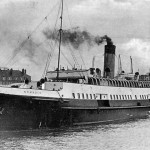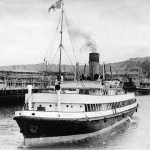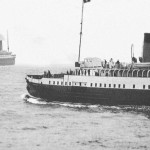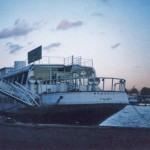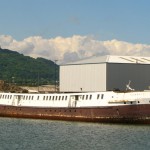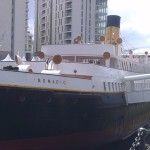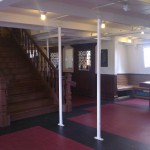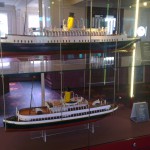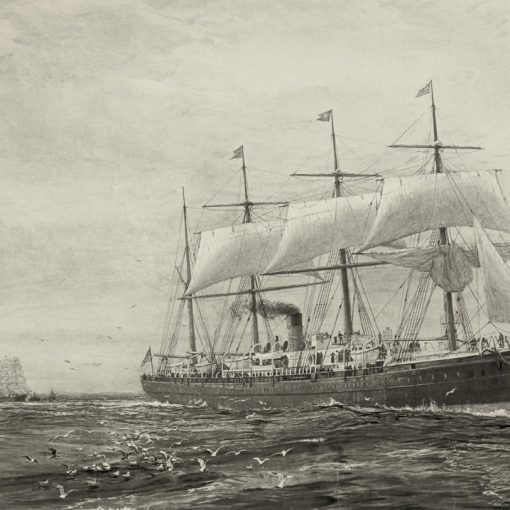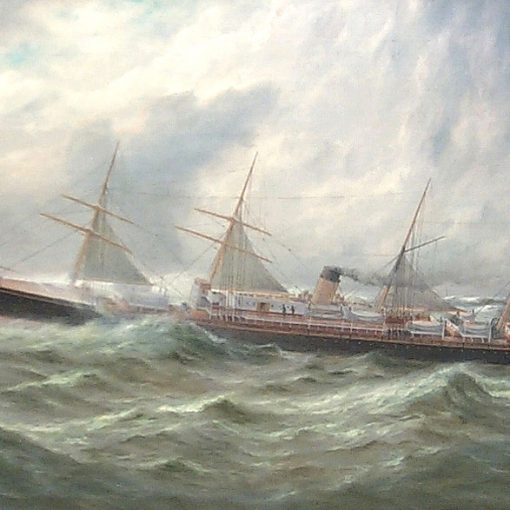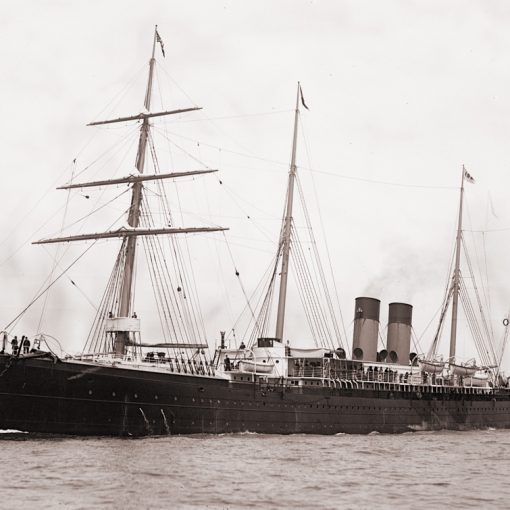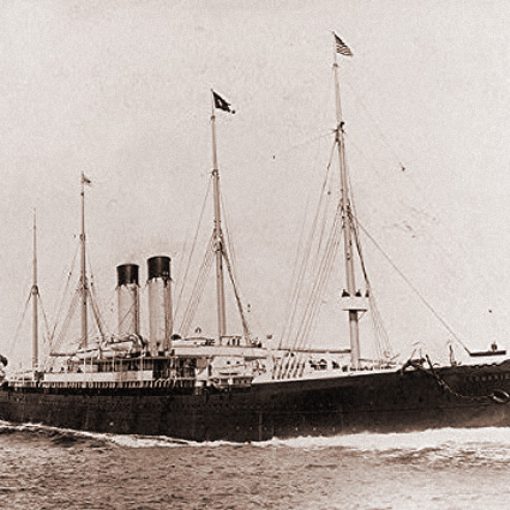Some of the busiest vessels in a shipping company’s fleet were not always the largest or the most famous ones. An important part of the business were the tender ships – the small ships that were used for carrying mail and passengers to the great liners in such ports where docking was impossible due to the liners’ immense size.
This is the story of the White Star tender Nomadic and her work mate Traffic, which were specially constructed to serve the Olympic-class ships. As fate would have it, the Nomadic was to be the longest surviving vessel of the great White Star fleet.
When the White Star Line put the Olympic into service on June 14th 1911, they took a giant leap forward. This new vessel – and her two future sisters – would make the company one of the foremost operating on the North Atlantic. However, putting such new and modern ships into service meant that some of the line’s older vessels seemed even more outdated.
This was absolutely the case with the line’s tender ship operating in the French port at Cherbourg – the Gallic. She had entered company service in 1907, but had been constructed already in 1894. She was an old paddle ship at 461 tons, and such an old-fashioned tender was not suited to serve the brand new Olympic-class liners.
During the summer of 1910, plans were made for two new tenders. They would be similar in design, but not actual sisters. On December 22nd 1910, the two tender’s keels were laid on slip no. 1. As the two mammoths Olympic and Titanic were taking shape side by side in the yards of Harland & Wolff, the Nomadic and Traffic were rapidly built in the vicinity.
One year after they had first been conceived, the two vessels were ready for launch. On April 25th 1911, the Nomadic took to the water. The Traffic followed two days later, on the 27th. A little less than a months later, on May 16th, the Nomadic went through her sea trials. Accordingly, the Traffic went through hers two days later. On May 27th, the two tenders were handed over to White Star, just in time to attend the Olympic’s sea trials the following day.
The Olympic’s sea trials were perfectly satisfactory, and when completed the new giant headed for Southampton. Her two tenders accompanied her. However, while the Olympic remained in Southampton for provisioning for her forthcoming maiden voyage, Nomadic and Traffic proceeded to Cherbourg where they would be stationed. Here they were registered in the name of the White Star Line’s local agent – George Lanièce. The Nomadic was the largest of the pair, at 1,273 tons, and would be used for carrying first class passenger to the company’s liners. The smaller Traffic of 675 tons was used for mail and passengers travelling in second and third class.
The routine of transferring mail and passengers had been carefully gone through before the new tenders entered service. Yet on their first day of work, when the Olympic called at Cherbourg on her maiden voyage, things did not work out as planned. The White Star Line’s chairman and managing director, Joseph Bruce Ismay, who otherwise enjoyed the new flag ship’s premiere voyage, was annoyed that the transfer had not run smoothly. However, when the procedure had been carefully reviewed, things would become much better.
Yet the Nomadic did not escape her share of bad luck. On November 13th 1911, she was involved in a minor collision with the American Line’s Philadelphia, which she was serving at the moment. The Nomadic’s bow was slightly damaged.
Five months later, the Nomadic and Traffic made their only acquaintance with the Titanic on April 12th, 1912. As fate would have it, Titanic would never visit the port of Cherbourg again.
Two years later, the First World War erupted. This war was to have an enormous impact on the shipping lines of the world, and the Nomadic and Traffic were both selected to serve as naval tenders at Brest. They were used for this purpose throughout the conflict, and did not see much action. After the Armistice, they were returned to the White Star Line for continued commercial service in the port of Cherbourg.
The two tenders remained in company service until the White Star Line was sold by IMM in 1927. The new owner of the company, Lord Kylsant, sold them to the French Compagnie Cherbourgeoise de Transbordement. However, they would remain at Cherbourg and operate with White Star ships.
The Nomadic and Traffic would remain under Transbordement ownership until 1934. During these years, the Traffic was the most unfortunate one. On June 5th 1929, she was involved in a minor collision with the Homeric. The Traffic’s rails and plates on the starboard side were damaged, and required repairs. Six months later, she again was damaged when she went alongside the Minnewaska in rough weather. The Minnewaska seemed to be somewhat of a nemesis for the Traffic and Nomadic, as she also collided with the Nomadic on November 29th, 1931.
In 1934, the White Star Line merged with the Cunard due to the hard economic times, and thereby created the new Cunard-White Star Line. The Nomadic and Traffic were considered surplus in the new company, and was sold to the Sociéte Cherbourgeoise de Remorquage et de Sauvetage. The Nomadic was now renamed Ingenieur Minard and the Traffic became the Ingenieur Riebell. Their old buff-coloured funnels were repainted black with a red band. They continued their service as tenders but were occasionally used for towing and salvage duty.
But when the 1930s came to and end, the world was facing another world war. When France fell in 1940, it meant that the two former White Star tenders had to do something to avoid being captured by the German forces. The Ingenieur Riebell, or former Traffic, was scuttled in the port, but was salvaged by the Germans to serve them as an armed coastal vessel. It was in this guise that she met her fate on January 17th 1941, when she was torpedoed by the British.
The Ingenieur Minard, or Nomadic, had managed to escape across the English Channel when France fell in 1940. She joined the British Navy and spent the duration of the war performing war duties along the south coast of England.
Fortunately, the Allied forces managed to defeat Adolf Hitler’s Germany, and peace was achieved in 1945. The Ingenieur Minard was now returned to the port of Cherbourg to continue her regular job as a tender. She remained there for almost 23 years, serving such great ships as the two Queens. But even this prosperous post-war era came to an end by the end of the 1960s. Air travel was now taking over the transatlantic trade, and Cunard withdrew the Queen Mary in 1967 and the Queen Elizabeth in 1968.
The same year the former Nomadic’s owner decided to sell the now ageing tender for demolition. She was sold for this purpose to the company of Somairec at Le Havre. It seemed as if the old tender would now meet her end. However, the now 57 year-old little ship was saved when she was sold for use as a floating restaurant. She was given back her old name Nomadic and placed on the river Seine in Paris, close to the Eiffel Tower. She remained there and was operated successfully until the closing years of the 20th century, but by then the old ship was in dire straits and business was slow. In the end, the Nomadic was seized by the Paris harbour authorities in 2002. In order to move the ship, some of Nomadic’s superstructure was removed so that she could be towed below the Seine’s bridges. In April 2003, the Nomadic was moved to Le Havre and was expected to be sold at scrap value.
However, it turned out that there were plenty of people who recognised the Nomadic for what she was – the last White Star vessel afloat. Emphasising this historical significance and her connection to the fabled Titanic, various historical societies managed to raise an impressive amount of funds in an effort to purchase the Nomadic. By shaping public opinion in the ‘Save Nomadic’ campaign, they finally secured the purchase with additional funds provided by the government of Northern Ireland.
So, instead of heading to the breakers, the Nomadic was placed on a marine transportation barge and was brought back home to Belfast, where she had once been built. She arrived there in July 2006, and work began to restore her original appearance. Placed in the Hamilton Dock, just a stone’s throw from the Titanic Belfast museum, she now stands as a proud living link to the past. Having been aboard her myself, I personally believe that she is a true gem in the Titanic quarter and well worth a visit!
| Very special thanks to Roy, Tom, Joy, Ginny, and Gayle of Nomadic Belfast, who were all instrumental in scheduling our visit on May 10th, 2014. The Nomadic was not open for visits at the time, due to a leg of Giro d’Italia being hosted by the city of Belfast, but the kindness and efforts by the above mentioned granted Daniel and myself the amazing opportunity to walk the decks of the Nomadic nonetheless. |

